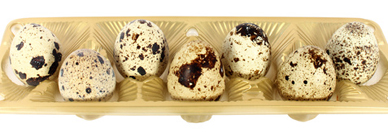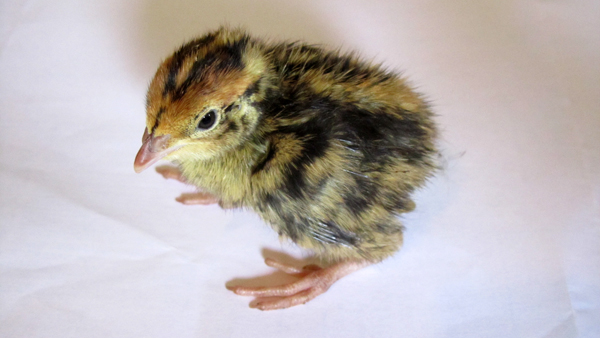Breed Focus: Japanese Quail (Coturnix)

Japanese Quail are particularly easy to look after, have very few specific requirements and can be kept inexpensively in relatively small hutches or runs. Joe Lat of Horton Hatchery takes a look at this diminutive but particularly versatile breed of poultry.
Japanese Quail are a member of the phasianidae family along with pheasants and partridges, and are therefore classified as a true game bird. Quail have been bred domestically, it is thought, more than 4000 years. Most modern quail are derived from Japanese strains. There are now over 100 recorded different quail breeds.
General characteristics
Japanese Quail are certainly multi-purpose. Their eggs, whilst small, are considered somewhat of a delicacy. Quail can also be kept for meat, indeed the Jumbo quail (which are Japanese Quail selectively bred for their size) are most suitable for rearing for the table. Quail can be shy and reserved and they do have a tendency to fly straight upward when startled, but if reared by hand they are more manageable. Their small size makes them an ideal pet for children. Expect an adult male to reach weights of 100-140g, whereas a female weighs in slightly heavier at 120-160g. We consider them to be an especially suitable species for a first-time bird keeper
Eggs
Quail are mature within about 6 weeks of age, and usually in full egg production by 50 days. Kept in optimum conditions, expect your hen to lay 200 eggs in their first year of lay. Hens do however need at least 14 hours of light a day to lay all year long, so in the UK it will be necessary to provide artificial lighting throughout the winter. Be careful not to use strong light however, as this will make the birds agitated. Most eggs are mottled brown and light, chalky blue in colour, but some hens do lay a pure white or pale blue only egg, although this is more unusual. They are approximately half the size of a standard hen’s egg, and are the smallest currently commercially available. Japanese Quail hens very rarely go broody, so you will need to incubate your eggs if you would like to rear your own young.

Given the right conditions you can expect 200 eggs a year – about how many you need for a decent omelette
Housing
Housing should be designed to cater for their most high-priority needs, which are litter for scratching and foraging, dust bathing, nest boxes and cover. Breeding pairs of quail can however be happily kept in relatively small cages. Hutches can be suitable, but will need to be adapted to provide maximum light availability, and must give at least 30cm of headroom. Because of their tiny delicate feet wire floors are not recommended. Many owners who keep quail as pets prefer to keep them in larger runs or aviaries, which means the frequency of cleaning is reduced. Whatever you do however, don’t let your quail free range as their tiny size makes them vulnerable to a wider range of predators than larger poultry and, unlike hens, they will not make their own way back to their own living quarters as night falls. Quail are also good at flying over short distances, in fact they are migratory birds by nature, so will soon go off exploring.
Males are relatively non-aggressive, but like all birds, they will peck feathers if kept in too high a density or a non-stimulating environment. Nest boxes are an important consideration. Breeding female quail will show pre-laying restlessness in a similar way to other domestic fowl. Quail do not perch, but instead they will appreciate cover, as they can be shy, retiring birds. Simple conifer screening (from cuttings if you have them) will be more than adequate for this purpose. Your quail will also appreciate a regular sand bath. Wood shavings, sawdust and sand are good litter materials, both for young and for adults. Straw may contain lice, and hay will get soiled easily and produce spores if it becomes damp. Quails small size and smaller droppings mean they have to be cleaned out less frequently than other birds.
Due to their hardy nature, quail are happy to be kept outside all year long, as long as they have clean, dry, draft free cover. As with all birds, and indeed livestock, care should be taken to prevent freezing of water during winter months.
Feeding
A proprietary game bird or turkey mix should be fed to quail, preferably crumbled to make it a more manageable size. Here at the Horton Hatchery our chicks thrive on standard chick crumbs, although if you wish your quail to grow at a faster pace, a blend of food with a higher protein value should be selected. In the wild, quail will naturally forage to find fruit, grains, small seeds and invertebrates. Quail enjoy the occasional treat, for example shop-bought dried mealworms, pasta, rice, sweetcorn and lettuce will all be eaten readily. Be careful however not to introduce any form of meat to the diet. Garden cuttings should also be avoided.
Healthcare
Quail are not particularly susceptible to any diseases or ailments, but as with chickens, care needs to be taken to prevent worms, lice and mites taking hold. Again, as will all birds, basic health checks during handling are fundamental, and any ailing birds should be isolated from the flock.
Particular care should be taken with young chicks to prevent injury to their delicate bodies. Due to the tiny size of very young quail, measures need to be taken to avoid drowning or excessive wetting making the birds cold. We use small automatic mushroom shaped drinkers for safety. Young quail are precocial by nature, meaning they are immediately self-sufficient, and will soon make their own way to food and water.
When transporting quail, take care to restrict head height – a smaller carrier is best.
Keeping your own quail
Quail are social animals and should most definitely not be kept alone. Females can be housed in single sex groups but males should only ever be housed in pairs. It is not necessary to keep a male bird for your hens to lay (unless of course you want to hatch your own chicks), but research has shown a ratio of 1 male to 4 females is optimum for production. Some say the males are more friendly and can also help reduce bullying amongst a group of hens. The average life expectancy is 2-4 years but, in laying hens, egg production will tail off quite dramatically after the second year.
6 Comments
Leave a reply
Poultry categories
Most recent Poultry articles
- Preventing egg laying problems in older hens with implants 15th March, 2017
- Integrating new chickens into an existing flock 15th May, 2016
- The nests in my heart – a personal view of ex-battery hens 22nd March, 2016
- Chicken FAQ: your most common chicken keeping questions answered 19th January, 2016
- Hens and herbs – no this is not a chicken recipe 08th October, 2015
- Feeding chickens: a balanced diet for backyard hens 16th April, 2015








Hi do you have any jumbo quail chicks for sale. thanks Dave
Hi Dave
You can contact Joe at Horton Hatchery direct using the details at the end of the article to check what stock they have available.
Im interested to by your quails can you please call me 07958017355
Hi. We don’t sell birds directly but contact details of a breeder appear at the end of the article. Many thanks
Hi im looking at quail breeding in the Shropshire area was wondering if there are any loal breeders that i could visit to gain more info hands on as it were as i think ive read every book going so far ?
Interesting article